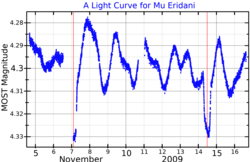Mu Eridani
 A light curve for Mu Eridani, adapted from Jerzykiewicz et al. (2013). The red lines show the times of mid-eclipse.[1] | |
| Observation data Epoch J2000.0 Equinox J2000.0 (ICRS) | |
|---|---|
| Constellation | Eridanus |
| Right ascension | 04h 45m 30.15038s[2] |
| Declination | −03° 15′ 16.7765″[2] |
| Apparent magnitude (V) | 4.00[3] |
| Characteristics | |
| Spectral type | B5 IV[4] |
| U−B color index | −0.60[3] |
| B−V color index | −0.15[3] |
| Variable type | SPB and Algol[5] |
| Astrometry | |
| Proper motion (μ) | RA: +0.25[2] mas/yr Dec.: −1.97[2] mas/yr |
| Parallax (π) | 6.25 ± 0.19 mas[2] |
| Distance | 520 ± 20 ly (160 ± 5 pc) |
| Absolute magnitude (MV) | −2.06±0.07[1] |
| Orbit[1] | |
| Period (P) | 7.38090 d |
| Eccentricity (e) | 0.344±0.021 |
| Periastron epoch (T) | 2455143.254±0.067 HJD |
| Argument of periastron (ω) (secondary) | 160.5±4.5° |
| Semi-amplitude (K1) (primary) | 0.344±0.021 km/s |
| Details | |
| μ Eri A | |
| Mass | 6.2±0.2[1] M☉ |
| Radius | 6.1[5] R☉ |
| Luminosity | 1,905[5] L☉ |
| Surface gravity (log g) | 3.5[1] cgs |
| Temperature | 15,668[5] K |
| Metallicity [Fe/H] | 0[1] dex |
| Rotational velocity (v sin i) | 130±3[5] km/s |
| Other designations | |
| Database references | |
| SIMBAD | data |
Mu Eridani (μ Eridani) is a binary star system in the constellation Eridanus. It is visible to the naked eye with an apparent visual magnitude of 4.00.[3] Based upon an annual parallax shift of 0.00625 arcseconds,[2] it is located roughly 520 light years from the Sun.
In 1910, this was determined to be a single-lined spectroscopic binary star system. The pair orbit each other with a period of 7.38 days and an eccentricity of 0.344, during which they undergo Algol-like eclipses.[1] The primary is a slowly pulsating B-type star[5] with a stellar classification of B5 IV.[4] The variability of the star's brightness due to pulsations was first detected by Gerald Handler et al. in 2004.[7] One year later, Mikołaj Jerzykiewicz et al. announced that eclipses had been detected.[8] It has a relatively high rate of rotation with a projected rotational velocity of 130 km/s, which is at least 30% of the star's break-up velocity.[5] The star has about six times the Sun's mass and radius, and it shines with 1,905 times the solar luminosity from its outer atmosphere at an effective temperature of 15,668 K.[1][5]
References
[edit]- ^ a b c d e f g h Jerzykiewicz, M.; et al. (June 2013), "μ Eridani from MOST and from the ground: an orbit, the SPB component's fundamental parameters and the SPB frequencies", Monthly Notices of the Royal Astronomical Society, 432 (2): 1032–1045, arXiv:1303.6812, Bibcode:2013MNRAS.432.1032J, doi:10.1093/mnras/stt522.
- ^ a b c d e f van Leeuwen, F. (2007), "Validation of the new Hipparcos reduction", Astronomy and Astrophysics, 474 (2): 653–664, arXiv:0708.1752, Bibcode:2007A&A...474..653V, doi:10.1051/0004-6361:20078357, S2CID 18759600.
- ^ a b c d Crawford, D. L.; et al. (1971), "Four-color, H-beta, and UBV photometry for bright B-type stars in the northern hemisphere", The Astronomical Journal, 76: 1058, Bibcode:1971AJ.....76.1058C, doi:10.1086/111220.
- ^ a b Levato, H. (January 1975), "Rotational velocities and spectral types for a sample of binary systems", Astronomy and Astrophysics Supplement Series, 19: 91–99, Bibcode:1975A&AS...19...91L.
- ^ a b c d e f g h Daszyńska-Daszkiewicz, J.; et al. (January 2015), "Oscillation modes in the rapidly rotating slowly pulsating B-type star μ Eridani", Monthly Notices of the Royal Astronomical Society, 446 (2): 1438–1448, arXiv:1410.6283, Bibcode:2015MNRAS.446.1438D, doi:10.1093/mnras/stu2216.
- ^ "mu. Eri". SIMBAD. Centre de données astronomiques de Strasbourg. Retrieved 2016-11-01.
- ^ Handler, G.; Shobbrook, R. R.; Jerzykiewicz, M.; Krisciunas, K.; Tshenye, T.; Rodríguez, E.; Costa, V.; Zhou, A. -Y.; Medupe, R.; Phorah, W. M.; Garrido, R.; Amado, P. J.; Paparó, M.; Zsuffa, D.; Ramokgali, L.; Crowe, R.; Purves, N.; Avila, R.; Knight, R.; Brassfield, E.; Kilmartin, P. M.; Cottrell, P. L. (January 2004). "Asteroseismology of the β Cephei star ν Eridani - I. Photometric observations and pulsational frequency analysis". Monthly Notices of the Royal Astronomical Society. 347 (2): 454–462. arXiv:astro-ph/0501263. Bibcode:2004MNRAS.347..454H. doi:10.1111/j.1365-2966.2004.07214.x. Retrieved 24 December 2024.
- ^ Jerzykiewicz, M.; Handler, G.; Shobbrook, R. R.; Pigulski, A.; Medupe, R.; Mokgwetsi, T.; Tlhagwane, P.; Rodríguez, E. (June 2005). "Asteroseismology of the β Cephei star ν Eridani - IV. The 2003-2004 multisite photometric campaign and the combined 2002-2004 data". Monthly Notices of the Royal Astronomical Society. 360 (2): 619–630. arXiv:astro-ph/0504238. Bibcode:2005MNRAS.360..619J. doi:10.1111/j.1365-2966.2005.09088.x. Retrieved 24 December 2024.
